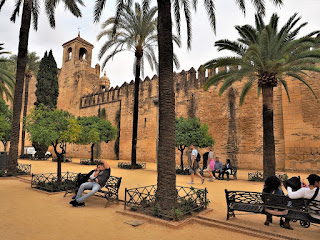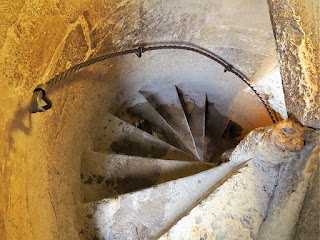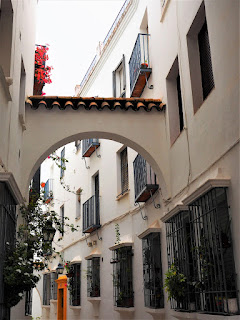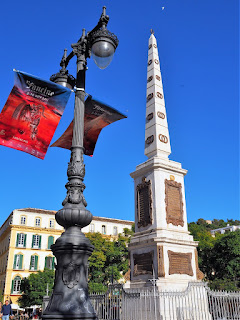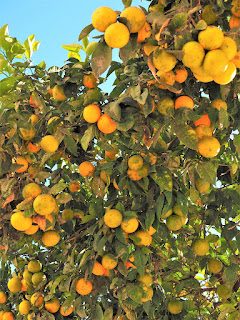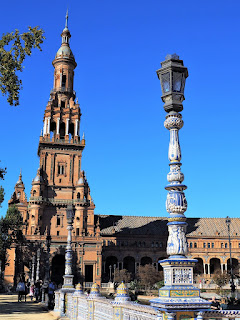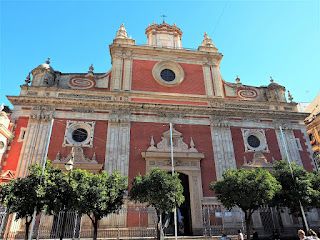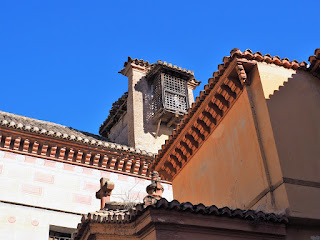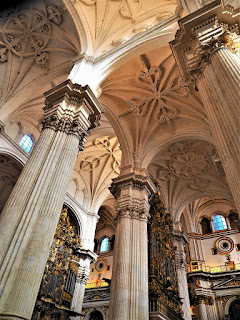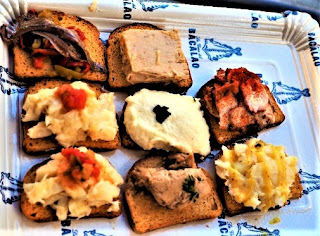Enjoy Gaudi and Moorish Architecture in Spain in 2017
(Part 2 of 2)
(Travel Story Series @ Hon Too Fang 2021)
D - Community of Andalusia
From Madrid we went south to the community of Andalusia, visiting the cities of Cordoba, Granada, Seville and Malaga. We are entering into a region ruled by the Muslim Moors for many years. A short description of several items is deemed necessary.
The Moors
In 711 the Muslim Berbers from northern Africa invaded the southern part of the Iberian Peninsula. They were later joined by the Arabs. Within 6 or 7 years the Muslims conquered almost 90% of the peninsula, easily defeating the army of the ailing Visigothic Kingdom. The Muslims initially ruled the region as part of the Umayyad Caliphate based in Damascus, and later the local Cordoba Caliphate. In western literature this group of Muslims are known as Moors, irrespective of their ethnic origins, whether Berber or Arab, etc.
To complete the brief history, Christian forces started to retake the Iberian Peninsula as early as 942 when the Hungarians had some success in the north. By 1250 all of the peninsula came back to Christian rule.
Mudejar style
Mudejar style in architecture refers to the application of decorative Islamic art to conventional Christian styles of architecture. The Islamic art involves motifs and patterning including stylized calligraphy and intricate geometric and vegetal forms. Unique features include horseshoe and multi-lobe arches, mugarna vaults, timber roofing, glazed ceramic tiles, etc. The style was popular during the 13th to 16th centuries.
E - Cordoba
Cordoba is a city some 395 km south of Madrid, population: 350,000. It was a Roman settlement, colonized by the Moors in the 8th century, became the capital of the Caliphate of Cordoba, ruling most of the Iberian Peninsula. It was recaptured by Christian forces in 1236.
Roman Bridge
The Roman Bridge is a masonry arch bridge across the Guadalquivir River, originally built in the 1st century AD by the Romans. The present form is dated to the 8th century, built by the Moors. Gates at both ends were constructed by the Moors. The length is 247 m and width about 9 m. The 1st photo was taken from the southern end while the 2nd from the northern end. At the southern end is a tower, 3rd photo and at the northern end, leading to the old city centre, is the bridge gate, last photo.
Cordoba Alcazar
The Alcazar of Cordoba, completed in 1328 served as the court of royals for the Christian monarchs. This is where Christopher Columbus was presented to Queen Isabella to explain his plans to discover the New World. The complex was designed in the Mudejar style. It is 4,100 sq m in area and completely surrounded by thick walls with 4 towers (only 3 still standing).
The lush gardens cover 55,000 sq m, dotted with fountains and statues of the former kings associated with the fortress.
Mosque-cathedral
This is a most fascinating religious building. A grand mosque built by the Muslim Moors from 786 to 987 was converted into a cathedral immediately after the Moors were driven off in 1236 by Christian forces, yet retaining many of the Moorish architectural features. It is a UNESCO World Heritage site since 1984.
The complex is surrounded by high walls with Moorish gates, about 20 of them. The site is 180 m by 130 m.
On the northern part is the courtyard called Court of Orange, with orange trees of course. The 2nd photo shows the Door of the Palms which is an entrance to the interior of the mosque-cathedral. At a corner is the massive 54 m high bell tower converted from a minaret. Shown a view of the mosque-cathedral structure and the orange trees and palm trees as viewed from the top of the bell tower, last photo.
Once inside one will be greeted with an awesome forest of columns receding into the distance, some 856 of them, topped with dazzling red-and-white arches. A fantastic sight to behold. The last photo shows the boundary between the original Muslim prayer hall and the Christian area of side chapels.
The remains of the Islamic element is highlighted by the "mihrab", a spectacular archway decorated with Arabic writing, pointing in the direction of Mecca where every Muslim would face in prayer. The vault with the Moorish design is retained.
The Catholic cathedral was constructed in the centre of the vast building from 1489 to 1606, with new vault and roof. Shown the high altar and the domed vault, the 1st two photos. The 3rd photo shows the Villaviciosa Chapel, which was the main place of worship in the initial days of the conversion of the mosque to a church.
The cathedral has more than 60 side chapels. Shown the altar pieces of the Chapel of Guardian Angel and Chapel of Saint John of Avila.
The historic inner city
Some shots in the old city: the Roman city wall, 2.65 km long, constructed around 200 BC and restored in the 1950s, the restored Corinthian columns of the ruins of a Roman temple, 3rd photo and the synagogue, built in 1315 and last restored in 1977. This is 1 of only 3 medieval synagogues still standing in Spain. The historic inner city is a UNESCO World Heritage Site.
Orange trees and cobbled streets.
Two delightful buildings: the Flamenco Centre Fosforito and the Viana Mansion. The flamenco is a dance form originated from this Andalusia region in Spain. The modern form emphasises on lightning fast footwork.
Street of Flowers
North of the Mosque-cathedral is a narrow street, Calleja de las Flores, famous for hanging plants and flowers on its wall. The neighbourhood is in fact touristic, selling all kind of souvenirs and curios.
Fernandine Churches
When King Fernando III captured Cordoba from the Moors, he started building small churches to serve all parts of the town. These are later called the Fernandine Churches, 12 of them. Shown the facades of 2 of them.
We visited a 3rd church though this one has been reconstructed in 1705. An unadorned exterior but well decorated inside. Many of the art works have been recently restored or replaced. The extremely ornate high altar, bordering being distasteful, is dated to 1724, 2nd photo while the delightful altar piece of Saint Mary of All Saints, 3rd photo, is a 2013 creation. The last photo shows a tiled patch on the exterior wall.
More street scenes
As usual, signing off with some street shots, this time a few decorative signs. The last one is a candid shot of 3 French ladies taking a selfie in front of the giant portrait poster of the great Flamenco singer Fosforito at his Flamenco Centre. I later emailed them the photo and in return received a long passage of French love. Confirmed with Google translate.
F - Malaga
We next went south to Malaga, a city of 570,000 people. It is the 6th most populous city in Spain but 4th in economic activities, helped by tourism and technology services. It is marketed as "the capital of Costa del Sol" or Coast of the Sun. We stayed at a time-sharing apartment "Sunset Beach Club" at Costa del Sol for a week, and from there made day-trips to a few other places.
Pablo Picasso
The favourite son of Malaga is Pablo Picasso (1881-1973), one of the most influential artists of the 20th century. He was born in Malaga but spent most of his adult life elsewhere. He was a painter, print-maker, sculptor, ceramicist, etc. Credited with the founding of the Cubist modern art movement and the invention of constructed sculptures. We visited the Picasso Museum where most of the exhibits are donated by him and his family. The museum building is an old house where he was born.
No photography is allowed in the museum. Shown a master piece by him titled "Girl before a Mirror" dated 1932, as shot from a poster. The girl is his mistress. And the 2nd photo shows Picasso selling tapas at a street corner! Free use of his image in advertisement. Just like images of Mozart were used in Vienna, Austria to sell everything and anything.
Malaga Cathedral
Cathedral again? What else in Europe dominating the landscape? OK, this time only 6 photos, chosen from a collection of 20+. The Gothic cathedral was built between 1528 and 1782. It is known fondly as La Manquita (One Armed Lady), because only the north tower was completed. The south tower remains unfinished. Shown the facade with the north tower, 84 m in height, and a carved medallion above one of the doors featuring St Paula who, together with St Ciriaco, are the patron saints of the city.
Now the interior. Ceiling near the main dome, the high altar, the choir stalls with 42 carved seats dated to the 17th century and lastly the elaborate altar piece of the side chapel of St Barbara. We attended a mass at the cathedral.
Cathedral Museum
This is a museum housing religious art pieces and liturgical objects, located in a building next to the cathedral. Shown 2 items: the "The Crucifixion" dated to 1500-1525 and "Infant Jesus Called the Little Husband" dated to 1795-1800.
Crystal and glass museum
Visited a highly-rated niche private museum on crystal and glassware where the tour guide was none other than the boastful owner who claimed to be a "European" royalty with private residences in several cities in Europe. Unfortunately we could understand less than 50% of what he tried to explain about glasses with his Germanic high-society English. Shown some glass items and a portrait of the owner's relative dating back to may be two hundred years, last photo.
Street scenes
As usual the last part is reserved for some street scenes. First look at 2 monuments: the monument to honour General Torrijos dated to 1842 for his liberal upraising, then a monument to honour Manuel Domingo Larios for bringing prosperity to this shopping street which is named after him. This is the most expensive real estate in Malaga.
The city is gearing for the Christmas tourist season. The sky over the shopping streets is decorated, with a modern sculpture vying for space. Down on earth the oranges are calling for attention too.
A medieval torture set and a wall mural near the Picasso Museum, not sure if the mural is a duplicate copy of the work of Picasso or not. Lastly a street performer at work and a menu display board with delightful calligraphy.
G - Seville
Seville is the capital of the region of Andalusia, population 703,000. It is 220 km north-west of Malaga. From Malaga we made a 2-day trip to this 4th largest city in Spain. A one-way bus fare costs about 16 Euro and takes 3 hours. In the old town the Alcazar, the Seville Cathedral and the General Archive of the Indies combined to be listed as a UNESCO World Heritage Site.
Plaza de Espana
This is a public square constructed for the 1929 Ibero-American World Fair Expo, built to represent Spain, a fusion of a 10th century Moorish structure with its connection to America. The square has a semi-circular shape and covers approximately 50,000 sq m. From the central building two long arcades spread out towards the towers. A very photogenic sight. Surprisingly there were very few tourists.
Along the arcades are 48 tiled alcoves to represent the 48 Spanish provinces. Shown those for Cordoba and the Balearic Islands. In fact a lot of ceramic tiles are used. Even on the balustrades and the lamp-posts.
Maria Luisa Park
This is a public park created in 1892 when the princess Maria Luisa donated the 100-acre land to the city. Now the biggest green lung in the city. Within the site are monuments and buildings constructed for the 1929 Ibero-American World Fair Expo, including the Plaza de Espana we have just covered. Quite tiring walking around the huge place. Shown are scenes at the park, the 2nd photo showing the Guatemala pavilion built for the 1929 Expo.
There is a small Archaeological Museum, shown 2 exhibits. The last 2 photo shows the Plaza de America built to showcase Spanish Mudejar architecture.
Seville Cathedral
The Gothic-style Seville Cathedral was built between 1402 and 1506. With a size of 135 m by 100 m, it is the largest church building in Spain and arguably the 3rd largest in the world. Together with the Alcazar and another building, they form a UNESCO World Heritage site.
There was too long a queue for tickets so we did not go inside this time. We did visited this church on our last visit here in 2010 on a group tour. The 93-m high Moorish bell tower, modified from the minaret of the former grand mosque, is the icon of Seville. The cathedral has 15 gates.
Shown some exterior views: the sea of spires typical of Gothic architecture and the upper part of the southern façade, the lower part under restoration. The 3rd photo shows the bell tower. And lastly the impressive main gate, called the Gate of Assumption, elaborately carved around 1877 to 1898.
Church of El Salvador
We did visited the interior of a church, the Church of El Salvador. The Baroque-style church was completed in 1712 and last renovated in 2008. The exterior is modest but the interior is ostentatiously ornate. The 2nd photo show part of the high altar. The 3rd shows murals on the ceiling and the last the pulpit.
Real Alcazar
Listed as part of a UNESCO World Heritage Site, the Alcázar started as the medieval fortress of Moorish rulers in the 10th century. After the Christian Re-conquest in the 1360s, the old buildings were mostly destroyed. But the Christian kings retained the fortress ground and built their palaces. Today the royal family still has the uppermost floor reserved as a royal residence. This is the greatest example of Andalusian Mudejar architecture in Spain, the application of decorative Islamic art to conventional Christian styles of architecture.
First the entrance Lion Gate and the Courtyard of Hunters, 1st 2 photos. Next the most beautiful courtyard: Courtyard of the Maidens, highlighting Islamic architecture with magnificent arches featuring open arabesque work above the 52 marble columns.
Inside there are many halls. The buildings used a lot of interlaced wood, tile decoration and horseshoe arches. The oldest and most beautiful of the halls is the Hall of Ambassadors meant for reception and ceremonies, with a splendid stalactitic dome ceiling and decorative friezes and inscriptions in the Arabic script. These halls were built by the Christian kings, employing Moorish artisans.
More details of the splendid Moorish architecture at the neighbouring rooms: Hall of Peter I, and the Royal Chapel.

Then the lush gardens.
Street scenes
The tall palm trees and the Monument to the Immaculate Conception in Del Triunfo Square competing for height, 1st 2 photos. A unique curved shopping arcade at the Del Calildo Square, and horse carriages at the vicinity of the Cathedral, next 2 photos. Lastly younger workers cleaning wall graffiti on the walls of the Cathedral and older men relaxing at the Nueva Square.
H - Granada
From Malaga we made a day trip to Granada, about 125 km to the north-east. The bus took about an hour and 45 minutes. Granada is a city with 240,000 people, the last city in Spain "liberated" by Christian forces in 1492.
Albaicin
The Moors ruled Granada from 711 to 1492, the longest of all Spanish cities. This old neighbourhood of the Moors, called Albaicin, is a UNESCO World Heritage Site. It is a big area on the slopes of the Sacromonte district. We just roamed around the lower part of the old quarters where most of the buildings have been restored to become classy homes with a garden, called a "carmen". The last photo shows part of the Alhambra towering over this old quarters. The Alhambra was the residence of the Moorish rulers from the 13th to the 15th centuries. We did not visit the old palace this time as we saw that in 2010.
Granada Cathedral
The Cathedral, built in 1523, is famous as an example of Spanish style Renaissance architecture. Revel the Renaissance splendour of the interior, characterised by precise symmetry, proportion and harmony, and the extensive use of columns, arches and domes. See the beautiful Corinthian columns in the 2nd photo and admire the classic dome and other structures over the high altar area, 3rd and 4th photos.
Each of the side chapels has a different artistic style, shown the Chapel of Saint Lucia dated to the 16th century and part of another altar piece.
Other buildings and monuments
Shown facades of 3 churches: the spires of the Royal Chapel, the Church of Saint Peter and Saint Paul, and the Church of Santos Justo y Pastor.
And 3 monuments: the Gigantones Fountain, dated to the 17th century, in the Rip Rambla Square and the Monument to the Isabella the Catholic, erected in 1892, to commemorate the meeting of Queen Isabella and Christopher Columbus before his voyage to explore the new World, and lastly, the Bulls Fountain (Pilar del Tora) dated to the 16th century in the Nueva Square, the biggest square in the city.
Street scenes
Some interesting street scenes include the painting on the roller shutter of a juice store, 3rd photo, and the distorted image of a building on another’s window, 4th photo. The last photo is an elegant man-hole cover found in Albaicin.
H - Before We Say Goodbye
Just a brief note on food and entrance tickets to tourist attractions.
We are just ordinary sight-seeing tourists from the Orient, not really attracted to fine dining in the Western World so we didn't take the extra mile to hunt for good or special food. Of course did taste the common famous dishes like paella (a rice dish), the Jamon Iberico (ham from black Iberican pig) and tapas, a bite-size appetizer or snack. Shown the seafood paella taken at La Rambla in Barcelona and the tapas, or Spanish "dim sum", taken at the San Migual Market in Madrid and a typical plate of garlic prawns, the dish called Gambas al Ajillo. We like their Gambas al Ajillo very much and often ordered that.
Likewise we are also not wine connoisseur and did not go for the wines. On drinks we like their ice-cold sangria, a fruit punch with red wine, lime juice, orange juice, etc. And we like very much their standard coffee, cafe con leche. It is essentially strong espresso with a generous portion of milk.
On this trip we stayed in apartments with kitchen facilities. We often made our own breakfasts. In Malaga, a sea port, we cooked a few seafood dinners with salmons, prawns and squids. To fry noodles we needed bean sprouts. This miserable 200 gm pack, priced may be 50 sen in Malaysia, cost us about RM 6 there.
Entrance tickets to tourist attractions could be quite expensive, up to 20 Euro for a public institutions like castles, palaces, etc. And more for those run by private corporations. Some churches offer free entrance, while some churches charge around 5 to 10 Euro.
In Barcelona all the 3 Antoni Gaudi attractions we went to were packed. For the Sagrada Familia tour we went in the morning and could only book a time slot in the late afternoon, and could not get a ticket to go up the towers. For Park Guell we went there mid-day and the tickets for the day were already sold out. We had to buy the next day's tickets. For Casa Batllo we brought the tickets from an agent, paying an extra fee of course. Shown the counterfoils of the entrance tickets to the 3 Gaudi sights.
The last shot: celebrating the conclusion of an enjoyable trip. This is the Gang of 4.
*** End of the story. Thanks for accompanying us on this virtual tour ***
(First written in the email format in May 2018, lightly revised to this PDF format in November 2021)






